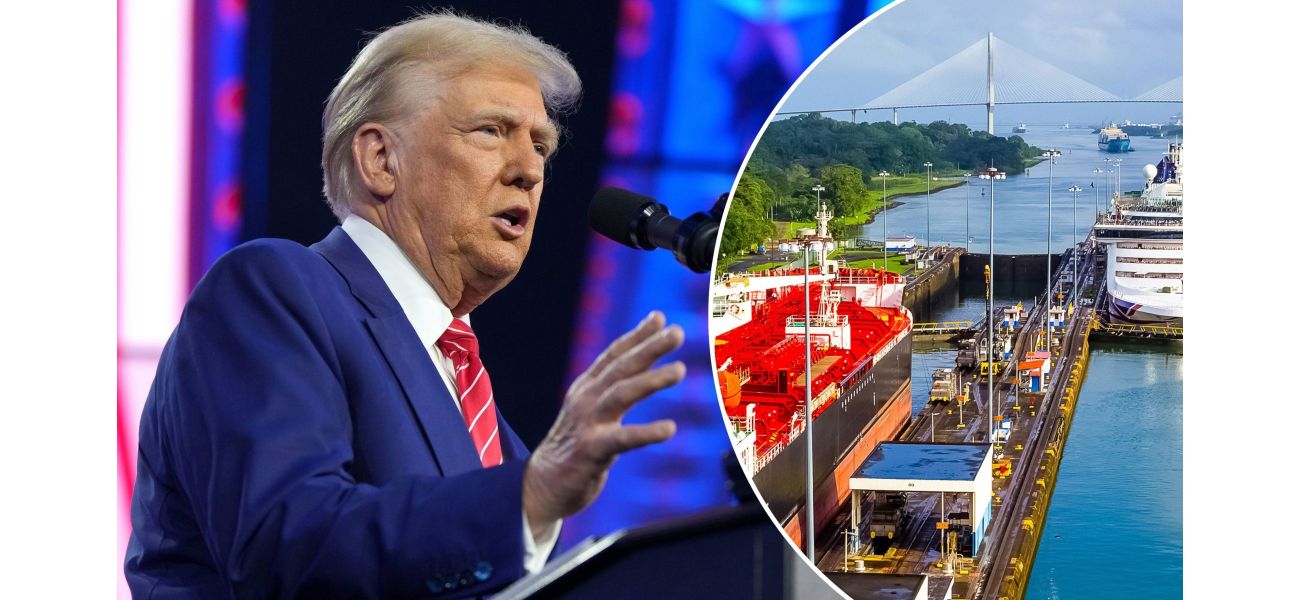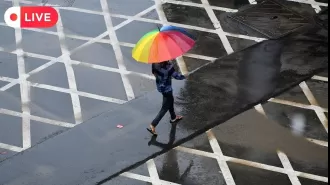Trump wants to regain control of the Panama Canal due to concerns about Chinese influence and potential economic benefits.
Trump accused Panama of overcharging the US for using the canal and suggested China may have increasing influence there in social media and remarks to supporters.
December 24th 2024.

Donald Trump, the newly elected President of the United States, recently made a suggestion that has caused quite a stir. He believes that the US should retake control of the Panama Canal, an idea that was quickly rejected by the Panamanian government, which has been in control of the canal for many years now. Trump took to social media and also made remarks to his supporters, accusing Panama of charging unfair rates for the use of the canal. He also hinted at growing Chinese influence in the area, which he believes could be a threat to US interests.
In a post on his social media platform, Truth Social, Trump wrote, "The fees being charged by Panama are ridiculous, especially considering the immense generosity that the US has shown towards them." This statement was made on a Saturday, and it caused quite a stir. The Panama Canal was built by the US in 1914 and was under their control until 1977, when an agreement was signed that gave Panama eventual control over the canal. However, the canal was jointly operated by both countries until 1999, when the Panamanian government took full control.
During a speech to a crowd of young conservatives in Phoenix on Sunday, Trump reiterated his stance on the issue. He stated that if the agreement was not being followed as intended, then the US would demand that the Panama Canal be returned to them. He added, "To the officials of Panama, please take this into consideration." However, it is unclear how serious Trump is about this threat, as this is not the first time he has accused the US of getting a raw deal.
One of the main concerns is how Trump plans on forcing a sovereign and friendly country to give up their own territory. The Panamanian government has made it clear that they want nothing to do with Trump's suggestion. President José Raúl Mulino stated in a Sunday statement that every square meter of the Panama Canal and its surrounding areas belong to Panama, and it will continue to be that way. He also emphasized that the sovereignty and independence of their country are non-negotiable.
The history of the Panama Canal has been fraught with tension and struggles. Before its completion, ships traveling between the east and west coasts of the Americas had to sail around Cape Horn, adding months to their journeys. This led to multiple attempts by different empires to create a passageway through the land. In the early 20th century, President Theodore Roosevelt made it a priority to build the canal. However, the territory was then under the control of the Republic of Colombia. With the help of the US, Panama gained its independence in 1903, and a treaty was signed that gave the US control over a 16km strip of land to build the canal.
The US completed the canal in 1914, solidifying their status as an engineering and technological superpower. However, this achievement came at a great human cost, with an estimated 5600 people dying during its construction. The canal proved to be an essential passageway during World War II, but tensions between the US and Panama continued to rise over disagreements about control and treatment of workers. This reached a peak in 1964 when anti-American riots led to deaths and the brief severing of diplomatic relations between the two countries.
Years of negotiations led to two treaties during President Jimmy Carter's administration, which declared the canal neutral and open to all vessels and provided for joint US-Panamanian control until 1999. The then-President stated that the Panamanian people were dissatisfied with the treaty, as it was drafted by the US and not signed by any Panamanian. However, he made it clear that the US had no right to intervene in Panama's internal affairs or take any military action against their country.
Not everyone supported Carter's plan, and in 1976, presidential candidate Ronald Reagan stated that the US was the rightful owner of the Canal Zone. Tensions continued to rise, and in the late 1980s, the US invaded Panama to remove Manuel Noriega from power. After Panama gained full control of the canal in 2000, shipping volume exceeded its capacity, leading to a massive expansion project. However, droughts in the area have caused issues, and the canal has had to impose restrictions and higher fees for usage.
Trump's main issue with the canal seems to be the fees charged by Panama, which he deems as unfair and ridiculous. He also believes that China is trying to exert more control over the canal and the surrounding area. In 2017, Panama signed a joint communique stating that they would not maintain any official ties with Taiwan, which China considers its territory. Since then, China's influence in the region has grown. However, the Panamanian president has made it clear that the canal is not under any foreign control, be it China, the US, or any other power.
This is not the first time Trump has expressed his desire to obtain or threaten to take control of foreign territory. He has previously suggested making Canada the 51st US state and has repeatedly floated the idea of buying Greenland from Denmark. Although these ideas have been dismissed, Trump seems undeterred. He resurrected the idea of buying Greenland over the weekend while announcing his pick for ambassador to Denmark. He stated that it is necessary for national security and freedom worldwide for the US to own and control Greenland.
In a post on his social media platform, Truth Social, Trump wrote, "The fees being charged by Panama are ridiculous, especially considering the immense generosity that the US has shown towards them." This statement was made on a Saturday, and it caused quite a stir. The Panama Canal was built by the US in 1914 and was under their control until 1977, when an agreement was signed that gave Panama eventual control over the canal. However, the canal was jointly operated by both countries until 1999, when the Panamanian government took full control.
During a speech to a crowd of young conservatives in Phoenix on Sunday, Trump reiterated his stance on the issue. He stated that if the agreement was not being followed as intended, then the US would demand that the Panama Canal be returned to them. He added, "To the officials of Panama, please take this into consideration." However, it is unclear how serious Trump is about this threat, as this is not the first time he has accused the US of getting a raw deal.
One of the main concerns is how Trump plans on forcing a sovereign and friendly country to give up their own territory. The Panamanian government has made it clear that they want nothing to do with Trump's suggestion. President José Raúl Mulino stated in a Sunday statement that every square meter of the Panama Canal and its surrounding areas belong to Panama, and it will continue to be that way. He also emphasized that the sovereignty and independence of their country are non-negotiable.
The history of the Panama Canal has been fraught with tension and struggles. Before its completion, ships traveling between the east and west coasts of the Americas had to sail around Cape Horn, adding months to their journeys. This led to multiple attempts by different empires to create a passageway through the land. In the early 20th century, President Theodore Roosevelt made it a priority to build the canal. However, the territory was then under the control of the Republic of Colombia. With the help of the US, Panama gained its independence in 1903, and a treaty was signed that gave the US control over a 16km strip of land to build the canal.
The US completed the canal in 1914, solidifying their status as an engineering and technological superpower. However, this achievement came at a great human cost, with an estimated 5600 people dying during its construction. The canal proved to be an essential passageway during World War II, but tensions between the US and Panama continued to rise over disagreements about control and treatment of workers. This reached a peak in 1964 when anti-American riots led to deaths and the brief severing of diplomatic relations between the two countries.
Years of negotiations led to two treaties during President Jimmy Carter's administration, which declared the canal neutral and open to all vessels and provided for joint US-Panamanian control until 1999. The then-President stated that the Panamanian people were dissatisfied with the treaty, as it was drafted by the US and not signed by any Panamanian. However, he made it clear that the US had no right to intervene in Panama's internal affairs or take any military action against their country.
Not everyone supported Carter's plan, and in 1976, presidential candidate Ronald Reagan stated that the US was the rightful owner of the Canal Zone. Tensions continued to rise, and in the late 1980s, the US invaded Panama to remove Manuel Noriega from power. After Panama gained full control of the canal in 2000, shipping volume exceeded its capacity, leading to a massive expansion project. However, droughts in the area have caused issues, and the canal has had to impose restrictions and higher fees for usage.
Trump's main issue with the canal seems to be the fees charged by Panama, which he deems as unfair and ridiculous. He also believes that China is trying to exert more control over the canal and the surrounding area. In 2017, Panama signed a joint communique stating that they would not maintain any official ties with Taiwan, which China considers its territory. Since then, China's influence in the region has grown. However, the Panamanian president has made it clear that the canal is not under any foreign control, be it China, the US, or any other power.
This is not the first time Trump has expressed his desire to obtain or threaten to take control of foreign territory. He has previously suggested making Canada the 51st US state and has repeatedly floated the idea of buying Greenland from Denmark. Although these ideas have been dismissed, Trump seems undeterred. He resurrected the idea of buying Greenland over the weekend while announcing his pick for ambassador to Denmark. He stated that it is necessary for national security and freedom worldwide for the US to own and control Greenland.
[This article has been trending online recently and has been generated with AI. Your feed is customized.]
[Generative AI is experimental.]
0
0
Submit Comment





